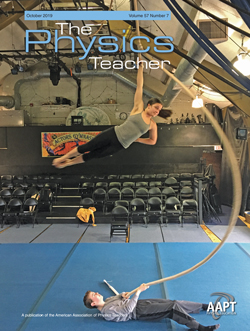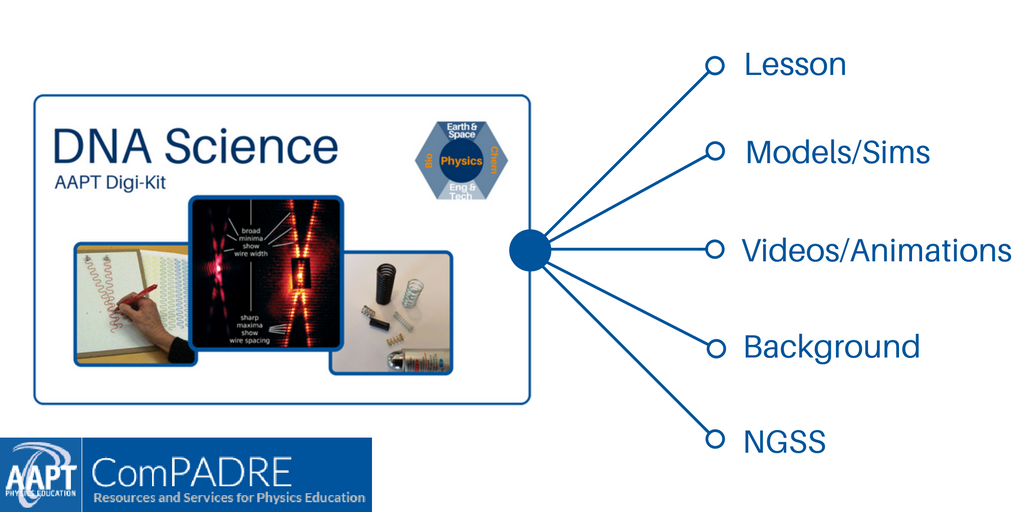The Physics Teacher
Volume 57 Issue 7, October 2019
Body Composition Analysis: The Physics of Measuring What We Are Made Of
This month's cover image beautifully captures the dynamic tension needed for a “fast spin.” Grace Louise Sherman’s “Circus Act” was among the top 100 entries in the AAPT High School Physics Photo Contest; Grace is a student of Emily Habbert at Evanston Township High School, Evanston, IL. See the articles "Body Composition Analysis: The Physics of Measuring What We Are Made Of," "Student Bench Press Power – A STEM Project for the Gym", and "A tennis ball accelerometer model" for other ways to bring physics into gym class.
Letters to the Editor
Comment on “A variable-mass snowball rolling down a snowy slope” by Kirk T. McDonald. DOI: 10.1119/1.5126814.
Analytic solution for a variable-mass snowball by Carl E. Mungan. DOI: 10.1119/1.5126815.
This cat has nine lives? by Joan Lubben. DOI: 10.1119/1.5126816.
Columns
And the Survey Says..., Astronotes, Figuring Physics, iPhysicsLabs, Physics Challenge for Teachers and Students, Fermi Questions, Little Gems, Talkin' Physics, Technology in the Classroom, and Websights.
Papers
Rocket Propulsion, Classical Relativity, and the Oberth Effect by Philip Rodriguez Blanco and Carl E. Mungan. DOI: 10.1119/1.5126818.
Robert A. Millikan and the Oil Drop Experiment by Isabel Bishop, Siyu Xian and Steve Feller. DOI: 10.1119/1.5126819.
Body Composition Analysis: The Physics of Measuring What We Are Made Of by Elliot Mylott, Elynne Kutschera and Ralf Widenhorn. DOI: 10.1119/1.5126820.
Student Bench Press Power – A STEM Project for the Gym by David Miles Headly and Howard Willard. DOI: 10.1119/1.5126821.
Entropy as Disorder: History of a Misconception by Dan Styer. DOI: 10.1119/1.5126822.
Stick With It! Helping Students Understand Free-Body Diagrams – A Magnet Activity as a Tool for Understanding by William Lo and Robert J. Beichner. DOI: 10.1119/1.5126823.
Modeling Energy Dynamics with the Energy-Interaction Diagram by Benedikt Harrer and Cassandra Paul. DOI: 10.1119/1.5126824.
A Tool to Study Fractals in an Interdisciplinary Perspective by P. V. S. Souza, R. L. Alves and W. F. Balthazar. DOI: 10.1119/1.5126825.
Solving Some “Calculus-Based” Physics Problems with Trigonometry by Dave Baum. DOI: 10.1119/1.5126826.
Time Scale for Velocity to Track a Force by Chris L. Lin. DOI: 10.1119/1.5126827.
Using Symmetry and Invariance to Solve Problems in Elementary Physics by Marc Frodyma and Sandy Rosas. DOI: 10.1119/1.5126828.
Uniform Circular Motion of a Spaceship and Its Relation to Free Fall by Adel Alameh. DOI: 10.1119/1.5126829.
Discovering Quantities of Circular Motion of a Light-Emitting Toy Train Using a Smartphone Light Sensor by Serkan Kapucu. DOI: 10.1119/1.5126830.
A Pictorial Explanation of Stellar Aberration by Carl E. Mungan. DOI: 10.1119/1.5126831.
Two-Dimensional Collisions and Conservation of Momentum by Lior M. Burko. DOI: 10.1119/1.5126832.
Damped Oscillations with a Smart Cart by Asif Shakur and Jeffrey Emmert. DOI: 10.1119/1.5126833.
The Coming Revolution in Physics Education by William Flannery. DOI: 10.1119/1.5126834.
Demonstration for Additive Colors by Defocus Blur by Wenqing Sun and Jun Wang. DOI: 10.1119/1.5126836.
Additional Resources
Race and Physics Teaching Collection Resource
DNA Science Lesson & Digi-Kit
Inspired by an article from The Physics Teacher, this multidisciplinary lesson and digital resource collection is based on How Rosalind Franklin Discovered the Helical Structure of DNA: Experiments in Diffraction (Braun, Tierney, & Schmitzer, 2011). Click the image to access this resource.



